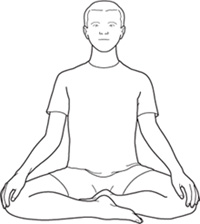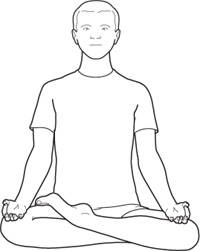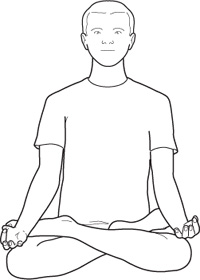The Zen Diet Revolution (6 page)
Read The Zen Diet Revolution Online
Authors: Martin Faulks
Tags: #The Mindful Path To Permanent Weight Loss

And finally, through meditation you learn to see things as they really are. You avoid being deluded and led into different alleyways. Sometimes our minds may try to fool us into thinking a situation is different than it really is; sometimes in meditation we feel we are in one state of mind when, in fact, we are not. It is not uncommon to spend five minutes thinking about tomorrow’s shopping while fooling ourselves into believing we are meditating. But before we can train our mind, we need to find a calm, stable position in which our body may remain undisturbed.
I recommended four different meditation postures. Try out each one and see which one made your mind calm and your body feel stable.
Throne posture
This posture is excellent for those who are unable, or prefer not, to sit cross-legged or in a kneeling position. It is the same pose that you will see in depictions of ancient Egyptian pharaohs sitting on a straight-backed chair (throne), feet comfortably placed flat on the floor and hands palm down on the thighs. Allow your shoulders to remain relaxed without slouching and your back firmly supported by the back of the chair, keeping your chin raised and the spine erect.
This is one of the best meditation postures in existence and one I was completely unaware of before I visited Japan. For years I was using more complicated postures, and after long periods my legs were numb. I also found it annoying that often I had to meditate when travelling or pushed for time and didn’t have time to warm up. This posture, very common in Japanese Zen practice, is a simple position to master compared to the traditional lotus posture and will be of use to you for the rest of your life. It also stretches the hips and opens them in preparation for the lotus posture. While sitting on the floor, the legs are bent and the feet placed in front of the pelvis, with one foot in front of the other. The hands rest at the top of the thighs or on the
heels. Feel free to adjust the position of the feet until you are comfortable; it is perfectly acceptable to have the feet either straight in front of each other or to let them pass so that one foot is next to the other ankle. You may also have to adjust the angle to allow you to place your calves or knees on the floor.
In the Burmese posture you must pay attention to keeping your legs on the floor. When you cross your legs in full or half lotus, the knees are naturally pushed down. Not so with the Burmese posture. It may take a while for you to sit comfortably in this position. To begin with you may not be able to rest your legs down comfortably, but don’t worry about this as you will find that this improves with practice. If you are already practising meditation, I advise you to convert to the Burmese posture.

Burmese posture
To begin, sit in the Burmese posture. Sit in a relaxed, upright manner. Place the right foot in the crease formed by the left thigh and the upper body. Adjust the left foot forward until it sits comfortably under the right knee. Your right leg should now be in a tight half lotus. Adjust your position so you can sit erect.
If your knee does not rest comfortably on the left foot, then gently press down with your right hand. Hold the stretch for 30 seconds or so and repeat. Never bounce your knee up and down. Repeat with the other leg.
Don’t worry if both knees don’t rest on the floor or mat. Time will remedy that in due course.
This posture should only be attempted when you are used to sitting for longer periods, and it may not be suitable for those with hip or knee problems.
Sit with your legs straight out before you, on a cushion or folded mat to elevate the hips, and allow the knees to sink through hip rotation. Keeping the back upright, bring your right leg into the cradle stretch position and externally rotate the right hip. Keep the right foot flexed, which helps prevent rotation at the knee and ankle joints. Place the right foot on top of the left thigh.
Relax the whole right leg. Now slowly bend the left knee in towards the folded right leg. Cross the left leg in front of you. Pick up your left foot and lower shin and gently lift it onto the right thigh. You have now completed the pose. The left knee may be slightly above the floor. Relax; with practice this will even up. Continue to sit in a balanced upright position. The ideal position is not hard to find: just watch your breathing and position yourself where it is most free and easy. Either rest the hands on the knees with the palms facing up or hold them together on your lap. Start by staying in the pose for brief periods, increasing your stay as your hips increase in flexibility.

Half lotus posture

Full lotus posture
When your legs grow tired, stretch them straight out before you and gently massage your knees. Cross your legs the other way around and practise on the other side.
The meditation starts with an awareness of the breath. Move your mind to your breath and let your whole body relax with every exhalation.
After observing your breath for a while, with each inhalation start to repeat the word ‘Here’. As you exhale, repeat the term ‘Now’. Continue with your double mantra. Every time you breathe in, repeat the word ‘Here’, then let your body exhale as you say ‘Now’. There is no need to say either of the words out loud; just ‘hear’ them in your imagination.
Make these words your focus and avoid getting pulled into other thoughts. You may find at the start that your mind tries to interrupt the process with all sorts of planning, evaluations and distractions. If at any time you have drifted off, don’t criticize yourself for thinking or let yourself get frustrated. Just become aware of your distraction and move your mind back to that ‘Here’ and ‘Now’.
Use your breath and the mantra to keep you connected to the present moment. Don’t let yourself drift off or snooze. Keep your mind on your breath and the mantra.
This meditation is the first step in understanding how
we can direct our internal experience, and in learning and understanding our unconscious habits. Soon you will notice what things disturb you and what things prevent you from being able to meditate effectively. Each time you notice a pattern, you have found out something about yourself.
As you persist with meditation, you will find a wonderful state of calmness associated with the practice. It is a calm awareness. Don’t expect or indeed look for a transcendental state of bliss. This calm feeling is known as the ‘relaxation response’ and carries with it many valuable health benefits, including stress prevention, regulation of blood pressure and an improved immune system. You may also find that this meditation produces mental clarity and a sense of wellbeing.
It is suggested that you practise for at least 20 minutes daily. If you can’t manage 20 minutes straightaway, try aiming for 5. Five minutes may seem like nothing, but make sure you can actually commit to this before you set yourself grander goals – a small amount is better than none at all.
I believe that using visualization and meditation, weight-loss goals can be achieved with less effort and permanent results. There have been countless studies showing that visualization can aid in the healing process and can increase athletic performance. It follows that it can aid your body in cutting body fat and motivating you to your
goal. Your future is dictated by your thoughts. What you think and feel now dictates your future actions. When you use your imagination to consciously practise a new way of thinking, you are literally reprogramming your mind. This is very important because the mental image that you have of yourself dictates many of your actions. When some people try to focus on weight-loss goals when their view of self conflicts with the end result, it brings about sadness and doubt rather than motivation and optimism. This exercise is the cure for that.
In this exercise, you are going to use your mind power to manifest your weight-loss and fitness dreams. As you practise, you should summon every bit of conviction and desire. You should fill yourself with a complete certainty that you are using the power of your mind to reshape your body.
I will provide a visualization meditation technique that exploits this immense power of thought and intention to help you with achieving weight loss and fat reduction. This conviction will greatly enhance the power and penetration of your thoughts to manifest your intentions. While you practise your visualization, it is important to remain positive no matter what. If your mind drifts or you have a negative thought or a doubt, bring it back to your visualization. I have found in my life that when I find it hard to focus or imagine a goal, there are still parts of my being that are unsure about its achievement. When I find I can dare to imagine the whole thing coming true, I know that it is going to happen! So part of this meditation is about getting rid of the doubts and negativity and about practising
staying positive. Things are bound to come up, and when they do, let them go and move back to the exercise. In your heart you can feel happy because you are getting rid of such things, but don’t dwell on them or let them distract you. It’s amazing how the laws of attraction work.
It is also important to enjoy the whole process; obesity and the tendency to overeat could be the product of many years of incorrect meal habits. All this could have come from something inside that needs to change. Irrepressible urges to eat could be driven from emotional hurt or a need for affection. Some people find that when they don’t feel loved, their mind drives them to some alternative. An easy alternative is food; from the moment of birth we have associated food with our mother and thus love and affection. Some people ran to their mother when they were upset and were comforted with food. All this started a program in the mind that has conditioned us to see food as being connected with comfort and affection.
Alternatively, the cause could be a genuine love for food that builds as time goes on (my hand goes up here) so much so that one of the most enjoyable parts of your day is planning your meals. Either way, your food focus has become a bit excessive. So it’s time to reprogram and give a positive association to new habits and your new goal and to break old programming. To do this, you need to enjoy your meditation.
Practise this exercise once a day and you will be amazed at the subtle changes that happen to your eating, exercise habits and emotional life. Sometimes you don’t notice
them for a couple of days and you realize that something brilliant has changed or that an improvement has been made.
Sit in your chosen meditation position or lie down. Make yourself comfortable. Close your eyes and relax the whole of your being. Move your mind to your breathing and take a few moments to relax.
Now that your mind and body are relaxed, it’s time for the first stage of the exercise. This is called the energy release. At this stage, you command your body to use your fat cells as its primary energy source.
Imagine a beautiful white light entering your body.
